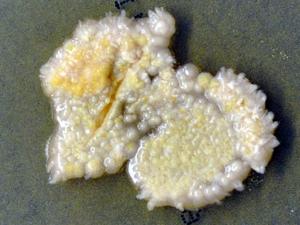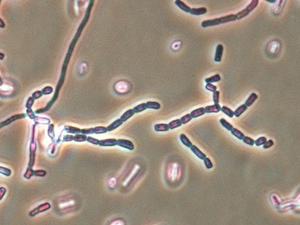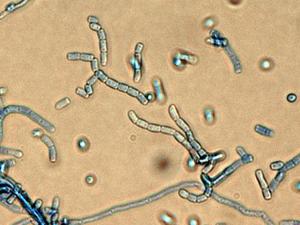Arthrographis kalrae
Arthrographis is an arthroconidial mould comprising four species: A. kalrae, A. lignicola, A. pinicola and A. alba.
These fungi are commonly found in environmental samples (soil, wood, air and water), but are isolated rarely from clinical specimens (Sandoval-Denis et al. 2014a).
RG-1 organism.
Morphological description:
Colonies with slow to moderate growth, creamy white to tan-coloured. Initially, yeast-like then developing hyphal growth and conidiophores subhyaline, narrow, branched, often in bundles, occasionally forming whitish, large 0.5 cm, linear synnemata. Arthroconidia are one-celled, hyaline, smooth-walled, oblong to cylindrical, with truncate ends, 2.5-9 x 1-2 µm. Spherical blastoconidia 2-4 x 2-3 µm, may also be formed laterally and sessile on undifferentiated hyphae. Chlamydospores may also be present. Very rarely immature ascomata submerged in the agar are produced. Growth at 42C, and on media containing cycloheximide.
Click images below to expand:
Photos of Arthrographis kalrae culture and arthroconidia.
Molecular identification:
ITS and D1/D2 sequencing may be used for accurate species identification (Sugiura and Hironaga 2010, Halliday et al. 2015).
Key features:
Keratinolytic, in vitro hair perforation positive, growth at 37C and tolerance to cycloheximide.
| No | ≤0.016 | 0.03 | 0.06 | 0.125 | 0.25 | 0.5 | 1 | 2 | 4 | ≥8 | |
|---|---|---|---|---|---|---|---|---|---|---|---|
| AmB | 13 | 1 | 6 | 2 | 4 | ||||||
| ISAV | 1 | 1 | |||||||||
| VORI | 13 | 1 | 4 | 5 | 2 | 1 | |||||
| POSA | 13 | 1 | 1 | 4 | 4 | 3 | |||||
| ITRA | 13 | 1 | 2 | 7 | 3 |
References: Sugiura and Hironaga (2010), Giraldo et al. (2014), Sandoval-Denis et al. (2014a), de Hoog et al. (2015).



